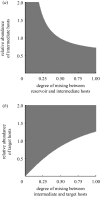Ecological factors driving the long-term evolution of influenza's host range
- PMID: 20444714
- PMCID: PMC2981989
- DOI: 10.1098/rspb.2010.0519
Ecological factors driving the long-term evolution of influenza's host range
Abstract
The evolution of a pathogen's host range is shaped by the ecology of its hosts and by the physiological traits that determine host specificity. For many pathogen traits, there is a trade-off: a phenotype suitable for infecting one set of hosts poorly infects another. Introducing and analysing a simple evo-epidemiological model, here we study how such a trade-off is expected to affect evolution of the host ranges of influenza viruses. We examine a quantitative trait underlying host specificity, given by an influenza virus's degree of adaptation to certain conformations of sialic acid receptors, and investigate how this receptor preference evolves in a minimal network of host species, including humans, that differ in life history and receptor physiology. Using adaptive dynamics theory, we establish thresholds in interspecific transmission rates and host population sizes that govern the emergence and persistence of human-adapted viruses. These ecological thresholds turn out to be largely independent of the strength of the evolutionary trade-off, underscoring the importance of ecological conditions in determining a disease's host range.
Figures



Similar articles
-
Influenza A Virus Agnostic Receptor Tropism Revealed Using a Novel Biological System with Terminal Sialic Acid Knockout Cells.J Virol. 2022 Aug 10;96(15):e0041622. doi: 10.1128/jvi.00416-22. Epub 2022 Jul 18. J Virol. 2022. PMID: 35862707 Free PMC article.
-
Enabling the 'host jump': structural determinants of receptor-binding specificity in influenza A viruses.Nat Rev Microbiol. 2014 Dec;12(12):822-31. doi: 10.1038/nrmicro3362. Epub 2014 Nov 10. Nat Rev Microbiol. 2014. PMID: 25383601 Review.
-
[Interspecies transmission, adaptation to humans and pathogenicity of animal influenza viruses].Pathol Biol (Paris). 2010 Apr;58(2):e59-68. doi: 10.1016/j.patbio.2010.01.012. Epub 2010 Mar 19. Pathol Biol (Paris). 2010. PMID: 20303675 Review. French.
-
Trade-offs between and within scales: environmental persistence and within-host fitness of avian influenza viruses.Proc Biol Sci. 2014 Jul 22;281(1787):20133051. doi: 10.1098/rspb.2013.3051. Proc Biol Sci. 2014. PMID: 24898369 Free PMC article.
-
6-sulfo sialyl Lewis X is the common receptor determinant recognized by H5, H6, H7 and H9 influenza viruses of terrestrial poultry.Virol J. 2008 Jul 24;5:85. doi: 10.1186/1743-422X-5-85. Virol J. 2008. PMID: 18652681 Free PMC article.
Cited by
-
Anticipating the species jump: surveillance for emerging viral threats.Zoonoses Public Health. 2012 May;59(3):155-63. doi: 10.1111/j.1863-2378.2011.01439.x. Epub 2011 Sep 14. Zoonoses Public Health. 2012. PMID: 21914152 Free PMC article. Review.
-
Why the human microbiome project should motivate epidemiologists to learn ecology.Epidemiology. 2010 Nov;21(6):757-9. doi: 10.1097/EDE.0b013e3181f4e1f9. Epidemiology. 2010. PMID: 20924228 Free PMC article. No abstract available.
References
-
- Andre J. B., Day T.2005The effect of disease life history on the evolutionary emergence of novel pathogens. Proc. R. Soc. B 272, 1949–1956 (doi:10.1098/rspb.2005.3170) - DOI - PMC - PubMed
-
- Antia R., Regoes R. R., Koella J. C., Bergstrom C. T.2003The role of evolution in the emergence of infectious diseases. Nature 426, 658–661 (doi:10.1038/nature02104) - DOI - PMC - PubMed
-
- Baigent S. J., McCauley J. W.2003Influenza type A in humans, mammals and birds: determinants of virus virulence, host-range and interspecies transmission. BioEssays 25, 657–671 (doi:10.1002/bies.10303) - DOI - PubMed
-
- Baranowski E., Ruiz-Jarabo C. M., Domingo E.2001Evolution of cell recognition by viruses. Science 292, 1102–1105 (doi:10.1126/science.1058613) - DOI - PubMed
-
- Bulaga L. L., Garber L., Senne D. A., Myers T. J., Good R., Wainwright S., Trock S., Suarez D. L.2003Epidemiologic and surveillance studies on avian influenza in live-bird markets in New York and New Jersey, 2001. Avian Dis. 47, 996–1001 (doi:10.1637/0005-2086-47.s3.996) - DOI - PubMed
Publication types
MeSH terms
Substances
Grants and funding
LinkOut - more resources
Full Text Sources
Medical

